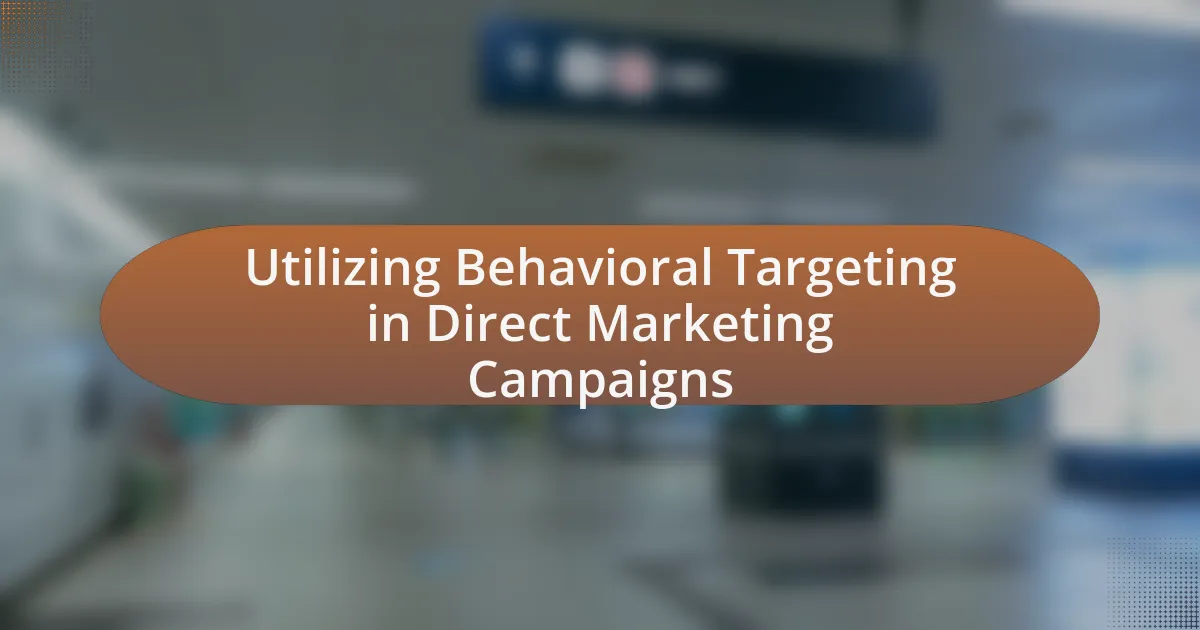A/B testing strategies for direct mail campaigns involve comparing two variations of a mail piece to assess which version yields better response rates and conversions. Key elements include defining objectives, selecting test variables, creating distinct mail versions, segmenting the audience, and analyzing performance metrics. The article highlights how A/B testing enhances campaign effectiveness by providing data-driven insights into consumer preferences, optimizing design and messaging, and improving targeting. Additionally, it discusses best practices for implementing A/B tests, common pitfalls to avoid, and the importance of analytics in refining direct mail strategies.
What are A/B Testing Strategies for Direct Mail Campaigns?
A/B testing strategies for direct mail campaigns involve comparing two variations of a mail piece to determine which performs better in terms of response rates or conversions. Key strategies include testing different headlines, offers, designs, or calls to action. For instance, a campaign might send one version with a bold headline and another with a more subtle approach to see which garners more engagement. Additionally, segmenting the audience based on demographics or past behaviors allows for more targeted testing, enhancing the relevance of the mail pieces. Implementing these strategies can lead to improved campaign effectiveness, as evidenced by studies showing that targeted direct mail can achieve response rates as high as 5% compared to the average of 1% for untargeted mail.
How do A/B testing strategies enhance direct mail campaigns?
A/B testing strategies enhance direct mail campaigns by allowing marketers to compare different versions of mail pieces to determine which performs better in terms of response rates and conversions. This method enables data-driven decision-making, as marketers can analyze metrics such as open rates, click-through rates, and overall engagement to identify the most effective design, messaging, or offer. For instance, a study by the Direct Marketing Association found that targeted direct mail campaigns can yield a response rate of 4.4%, significantly higher than email’s average response rate of 0.12%, demonstrating the potential impact of optimizing direct mail through A/B testing.
What are the key elements of A/B testing in direct mail?
The key elements of A/B testing in direct mail include defining the objective, selecting variables to test, creating two distinct versions of the mail piece, segmenting the audience, and analyzing the results. Defining the objective ensures clarity on what the test aims to achieve, such as increasing response rates or improving conversion. Selecting variables, such as headlines, images, or offers, allows marketers to isolate factors that may influence performance. Creating two distinct versions ensures that only one variable is changed at a time, facilitating accurate comparisons. Segmenting the audience helps in targeting specific groups, which can lead to more relevant insights. Finally, analyzing the results involves measuring performance metrics, such as response rates and ROI, to determine which version performed better, thereby validating the effectiveness of the changes made.
How can A/B testing improve response rates in direct mail?
A/B testing can improve response rates in direct mail by allowing marketers to compare different versions of mail pieces to determine which one resonates more with the target audience. This method enables the identification of effective elements such as messaging, design, and offers, leading to optimized campaigns. For instance, a study by the Direct Marketing Association found that targeted direct mail campaigns can achieve response rates of 4.4%, significantly higher than the average response rate of 0.12% for email marketing. By systematically testing variations, marketers can refine their strategies based on data-driven insights, ultimately increasing engagement and conversion rates.
Why is A/B testing important for direct mail marketing?
A/B testing is important for direct mail marketing because it allows marketers to compare different versions of mail pieces to determine which one performs better in terms of response rates and conversions. By systematically testing variables such as design, messaging, and offers, marketers can make data-driven decisions that enhance the effectiveness of their campaigns. Research indicates that A/B testing can lead to significant improvements in response rates; for example, a study by the Direct Marketing Association found that targeted direct mail campaigns can achieve response rates of 4.4%, compared to 0.12% for email marketing, highlighting the potential impact of optimizing direct mail through A/B testing.
What insights can A/B testing provide for marketers?
A/B testing provides marketers with critical insights into consumer preferences and behavior by comparing two variations of a marketing element to determine which performs better. This method allows marketers to identify the most effective messaging, design, or call-to-action, leading to improved engagement and conversion rates. For instance, a study by Optimizely found that A/B testing can increase conversion rates by up to 49% when the winning variant is implemented. By analyzing metrics such as click-through rates and response rates, marketers can make data-driven decisions that enhance the effectiveness of their direct mail campaigns.
How does A/B testing contribute to better targeting?
A/B testing enhances targeting by allowing marketers to compare two variations of a direct mail campaign to determine which one resonates better with the audience. This method provides data-driven insights into customer preferences, enabling marketers to refine their messaging, design, and offers based on actual performance metrics. For instance, a study by the Direct Marketing Association found that targeted direct mail campaigns can achieve response rates of up to 4.4%, significantly higher than the 0.12% response rate for non-targeted campaigns. This evidence illustrates how A/B testing leads to more effective targeting by identifying the most compelling elements for specific segments of the audience.
What are the different types of A/B tests for direct mail campaigns?
The different types of A/B tests for direct mail campaigns include testing variations in design, messaging, offers, and targeting. Design tests involve comparing different layouts, colors, or images to determine which attracts more attention. Messaging tests focus on variations in the text, such as headlines or calls to action, to see which resonates better with the audience. Offer tests evaluate different promotions or incentives to identify which drives higher response rates. Targeting tests assess the effectiveness of different audience segments to optimize engagement. Each type of test provides insights that can enhance the overall effectiveness of direct mail campaigns.
How can variations in design impact A/B testing results?
Variations in design can significantly impact A/B testing results by influencing user engagement and conversion rates. For instance, changes in color, layout, or imagery can alter how recipients perceive the message and interact with the content. Research indicates that a 10% increase in visual appeal can lead to a 20% increase in conversion rates, demonstrating the direct correlation between design elements and performance metrics. Therefore, even minor design variations can yield substantial differences in A/B testing outcomes, underscoring the importance of thoughtful design in optimizing direct mail campaigns.
What design elements should be tested in direct mail?
Design elements that should be tested in direct mail include layout, color schemes, typography, images, and calls to action. Testing different layouts can reveal which arrangement of text and visuals captures attention most effectively. Color schemes can influence emotional responses and brand recognition, while typography affects readability and engagement. The choice of images can enhance the message or evoke specific feelings, and varying calls to action can determine which prompts lead to higher response rates. Research indicates that direct mail pieces with personalized elements, such as recipient names or tailored offers, can significantly increase engagement, demonstrating the importance of testing these design components for optimal campaign performance.
How do color choices affect response rates in A/B testing?
Color choices significantly influence response rates in A/B testing by impacting emotional reactions and perceptions of the material. Research indicates that colors can evoke specific feelings; for example, red often generates urgency, while blue conveys trust. A study by HubSpot found that changing a call-to-action button from green to red increased conversions by 21%. This demonstrates that strategic color selection can enhance engagement and drive higher response rates in direct mail campaigns.
What messaging strategies can be tested in A/B campaigns?
Messaging strategies that can be tested in A/B campaigns include variations in subject lines, call-to-action phrases, content tone, personalization elements, and visual design. Testing different subject lines can reveal which ones generate higher open rates, while varying call-to-action phrases can help identify which prompts lead to more conversions. Adjusting the tone of the message, such as formal versus casual, can impact audience engagement. Personalization, such as including the recipient’s name or tailored content based on demographics, can also be tested for effectiveness. Lastly, changes in visual design, including layout and color schemes, can influence the overall response rate. These strategies are supported by data showing that targeted messaging can significantly improve campaign performance metrics.
How does the tone of the message influence A/B testing outcomes?
The tone of the message significantly influences A/B testing outcomes by affecting recipient engagement and response rates. A positive, friendly tone can enhance emotional connection, leading to higher open and conversion rates, while a formal or negative tone may result in lower engagement. Research indicates that messages with a conversational tone can increase response rates by up to 20%, demonstrating the importance of tone in direct mail campaigns.
What call-to-action phrases yield the best results?
Call-to-action phrases that yield the best results include “Get Started Today,” “Claim Your Free Trial,” and “Join Us Now.” These phrases are effective because they create a sense of urgency and encourage immediate action. Research indicates that phrases emphasizing exclusivity and urgency, such as “Limited Time Offer” or “Act Now,” can increase response rates by up to 30% in direct mail campaigns. Additionally, using clear and direct language helps eliminate ambiguity, making it easier for recipients to understand what action they should take.
How can one effectively implement A/B testing in direct mail campaigns?
To effectively implement A/B testing in direct mail campaigns, one should first define clear objectives and hypotheses for the test. This involves selecting specific variables to test, such as different headlines, images, or offers, and then creating two distinct versions of the mail piece. The next step is to segment the target audience randomly, ensuring that each group receives one version of the mail piece to eliminate bias.
After sending out the mail, it is crucial to track and analyze the response rates and other relevant metrics, such as conversion rates or return on investment, to determine which version performed better. For instance, a study by the Data & Marketing Association found that targeted direct mail campaigns can yield a response rate of 4.4%, significantly higher than email’s average response rate of 0.12%. This data supports the effectiveness of A/B testing in optimizing direct mail strategies.
What steps are involved in setting up an A/B test for direct mail?
To set up an A/B test for direct mail, follow these steps: first, define the objective of the test, such as increasing response rates or improving conversion rates. Next, identify the variables to test, which could include different designs, messaging, or offers. Then, create two distinct versions of the direct mail piece, ensuring that only one variable differs between them. After that, segment your audience randomly into two groups, ensuring each group receives one version of the mail. Finally, track and analyze the results based on the defined objective, using metrics like response rates or sales generated to determine which version performed better. This structured approach is essential for obtaining valid and actionable insights from the A/B test.
How do you define your goals before starting an A/B test?
To define goals before starting an A/B test, identify specific metrics that align with the overall objectives of the direct mail campaign. These metrics could include response rates, conversion rates, or customer engagement levels. Establishing clear, measurable goals ensures that the A/B test can effectively evaluate the impact of different variables on campaign performance. For instance, if the goal is to increase response rates, setting a target percentage increase provides a concrete benchmark for success. This approach is supported by research indicating that well-defined goals lead to more focused testing and actionable insights, ultimately enhancing the effectiveness of marketing strategies.
What sample size is necessary for reliable A/B testing results?
A sample size of at least 1,000 participants per variant is necessary for reliable A/B testing results. This size helps ensure statistical significance and reduces the margin of error, allowing for more accurate conclusions about the effectiveness of different strategies. Research indicates that smaller sample sizes can lead to unreliable results due to variability and insufficient power to detect meaningful differences.
What tools and resources are available for A/B testing in direct mail?
Tools and resources available for A/B testing in direct mail include specialized software platforms, analytics tools, and mailing services that facilitate testing different versions of mail pieces. For instance, platforms like Mailchimp and Constant Contact offer A/B testing features that allow marketers to compare different designs, messages, or offers. Additionally, analytics tools such as Google Analytics can track responses from direct mail campaigns when integrated with unique URLs or QR codes. Mailing services like USPS and FedEx provide insights on delivery and response rates, which can be crucial for evaluating A/B test outcomes. These tools collectively enable marketers to optimize their direct mail strategies based on data-driven insights.
Which software can assist in tracking A/B test performance?
Google Optimize is a software that can assist in tracking A/B test performance. It allows users to create and analyze experiments on their websites, providing insights into user behavior and conversion rates. Google Optimize integrates seamlessly with Google Analytics, enabling detailed reporting and data analysis, which supports informed decision-making based on A/B test results.
How can analytics improve the A/B testing process?
Analytics can significantly enhance the A/B testing process by providing data-driven insights that inform decision-making. By analyzing user behavior and engagement metrics, marketers can identify which variations of a campaign resonate more effectively with the target audience. For instance, analytics tools can track open rates, response rates, and conversion rates, allowing for a precise evaluation of each A/B test variant. This data enables marketers to make informed adjustments to their strategies, optimizing future campaigns based on empirical evidence rather than assumptions.
What are the best practices for A/B testing in direct mail campaigns?
The best practices for A/B testing in direct mail campaigns include defining clear objectives, segmenting the audience, testing one variable at a time, and analyzing results thoroughly. Clear objectives ensure that the test focuses on specific outcomes, such as response rates or conversion rates. Segmenting the audience allows for targeted testing, which can yield more relevant insights. Testing one variable at a time, such as the design or the call-to-action, helps isolate the impact of that variable on the campaign’s performance. Finally, thorough analysis of the results, including statistical significance, provides actionable insights for future campaigns. These practices are supported by industry standards that emphasize the importance of structured testing to optimize marketing effectiveness.
How can marketers ensure accurate results in their A/B tests?
Marketers can ensure accurate results in their A/B tests by implementing a well-defined testing strategy that includes randomization, sufficient sample size, and clear metrics for evaluation. Randomization minimizes bias by ensuring that each participant has an equal chance of being assigned to either group, which is crucial for the validity of the results. A sufficient sample size is necessary to achieve statistical significance, reducing the likelihood of errors; for instance, a sample size calculator can help determine the appropriate number of participants needed based on expected conversion rates. Additionally, establishing clear metrics allows marketers to objectively measure the performance of each variant, ensuring that the results are actionable and relevant.
What common pitfalls should be avoided during A/B testing?
Common pitfalls to avoid during A/B testing include insufficient sample size, which can lead to inconclusive results, and not running tests long enough to account for variability in user behavior. Additionally, failing to define clear objectives can result in ambiguous outcomes, while testing multiple variables simultaneously can complicate the analysis and interpretation of results. Lastly, neglecting to segment audiences may overlook important differences in responses, leading to misleading conclusions. These pitfalls can significantly undermine the effectiveness of A/B testing, as evidenced by studies showing that proper sample sizes and clear objectives are critical for reliable data interpretation.

















